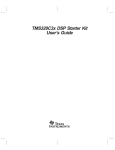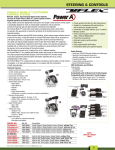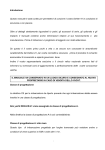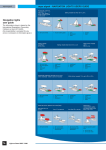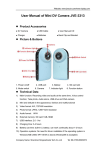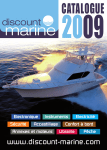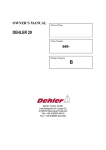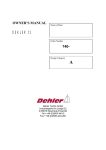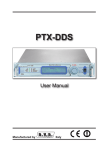Download Aqua Signal Bi Color Lights Series 20
Transcript
Mounting Instructions for Navigation Lights aqua signal 40 / 41 / 42 / 50 -1- aqua signal 40 / 41 / 42 / 50 Mounting Instructions for Navigation Lights of type AQUA SIGNAL 40 / 41 / 42 / 50 These navigation lights comply with the national and international regulations regarding minimum range of visibility, luminous intensity of horizontal and vertical sectors, and colour specifications for vessels of 20 metres and more in length (Regulations for Preventing Collisions at Sea). Lights marked ¥ D in addition to the DHI resp. BSH marking may be utilized on European inland waterways. However, their correct function will only be guaranteed and in conformance with the regulations if some important points are considered regarding mounting and maintenance. It is therefore essential to study the following pages attentively. Important: The upper lens compartment of double lens lights is always to be used within the main lighting system whilst the lower one belongs to the stand-by system. Regulations For all ships the rules set forth in Annex 1 to the International Regulations for Preventing Collisions at Sea - Positioning and Technical Details of Lights and Signalling Shapes - must be adhered to. The technical data regarding horizontal and vertical positioning and spacing of the navigation and signalling lights laid down in these mounting instructions do apply to all ships irrespective of their flag. A = horizontal plane CWL = construction waterline Keel line Lantern screen Arrow-marking Mounting of navigation lights in general* The lights must be positioned in and above keel line resp. parallel with it. Their horizontal plane (A) must be parallel with the construction water line (CWL). Their light must not be obstructed by parts of the vessel or objects or persons aboard within a vertical sector of ± 10° and a horizontal sector corresponding to the one of the lights. Their relative positions to the vessel are not to be changed while in operation. The vertical distance (C) must be minimum 4,5 metres respectively sufficient to allow recognizing the after masthead light over and separate from the forward light under all conditions of trim at a distance of 1000 metres. These lights are to be operated exclusively with special approved bulbs. These special bulbs from AQUA SIGNAL are labeled as follows: 10W ZP D 1301/1303 resp. 25W ZP D1302/1304 * Deviating from the anti collision regulations the forward masthead light needs be fitted only 5 metres above the hull and the after masthead light just 3 metres higher if the vessel is designed and registered for operation on European inland waterways until the border of high seas navigation. -2- aqua signal 40 / 41 / 42 / 50 Mounting Instructions MOUNTING INSTRUCTIONS IN GENERAL . The lights must be positioned in or parallel to the keel line. Their horizontal plane (A) must be parallel with the construction water line (CWL). Their light must not be obstructed by any parts of the vessel or objects or persons. Their relative positions to the vessel are not to be changed while in operation. An upside down mounting is not permissible. Important note for port and starboard lights In case screens are used for the sidelights the front screen has to be removed since it is not necessary and is obstructing the light output in right ahead direction. DESCRIPTIONS SIDELIGHTS SSb + SBb 40/41/42/50 ¥ Sidelights -STRONG- red/green SSb + SBb 50 angle 112,5° visibility 2 nm BICOLOR SIDELIGHTS TD 40/41/50 ¥ Bicolor sidelights -STRONG- red/green TD 50 angle 112,5° red and 112,5° green visibility 2 nm TRICOLOR LIGHTS FOR SAILING BOATS TDH 40, TDH 40 “quicfits” angle 112,5° red, 112,5° green, 135° white visibility 2 nm min. for all sectors COMB. TRICOLOR/ANCHOR LIGHT TDH / SW 40, TDH / SW “quicfits” FOR SAILING VESSELS angles: tricolor 112,5° red, 112,5° green, 135° white anchor 360° white visibility 2 nm min. Regulations for navigation lights Types TDH and TDH/SW40 with and without “quicfits” The regulations are permitting to use these lights only on sailing boats <20m. While under engine these lights are not permitted. MASTHEAD LIGHT T40/41/50 angle 225° visibility 3 nm + COMB. MASTHEAD/ANCHOR LIGHT T/SW 40 angles: masthead 225°, visibility 3 nm signalling 360°, visibility 2 nm STERN LIGHT H40/41/42/50 + HGe 40 (stern yellow, towing) angle 135° visibility 2 nm SIGNALLING LIGHTS SW, SR, SG, SGE 40/50 angle 360°, visibility min. 2 nm These lights are available for pedestal mount and for hoisting -3- aqua signal 40 / 41 / 42 / 50 The following lights are exclusively for navigation on European inland waterways ¥ D Blind plug Masthead Light -white/STRONG- TW 50 Signalling light blue-ORDINARY SB 40 Signalling light FLASHING -white-STRONG- SW40 The signalling flashing light has to be equipped with an approved electronic flasher. The light and the electronic flasher have to be mounted separately. (Please refer to instructions of electronic flasher.) Clamp washer Bottom Cable entry “YELLOW HORN SIGNAL” with Signalling signal light YELLOW-STRONG SGe40 Pin connections: 3 Tricolour light 1 Strobe light 2 Anchor light Combined WHITE/YELLOW (flash/horn) SIGNAL LIGHT Yellow-STRONG / flash-white-STRONG SGe/SW40 The signalling flashing light has to be equipped with an approved electronic flasher. The light and the electronic flasher have to be mounted separately. (Please refer to instructions of electronic flasher.) Right ahead direction Electronic flasher BG 50 G The flasher is designed to operate with a supply voltage of 830V DC. Only the control lamp has to be selected according to the main supply voltage on board. Technical details: Charge: max. 35W Voltage: 8-30V, Frequency: 60 fl./min. Fuse: 2A delay action fuse, Bright-phase: 50% Electrical connection by use of terminal Pin connections are identical with all types. Non-available lantern functions remain unused -4- aqua signal 40 / 41 / 42 / 50 MOUNTING Locking screw Silicon Sidelights Series 40 + 50 The enclosed bracket has to be fitted with 2 screws. Please pay attention to the right ahead direction. The light is hooked on the bracket. To obtain a vibration safe holding turn the locking device at the rear of the light to one side. Sidelights Series 41 Use backplate to mark hole alignment for drilling. Fix backplate with 2 screws dia. max. 4 mm horizontally or vertically. Place housing on the backplate and fasten it by tightening the screw at the bottom. Sidelights Series 42 Use the attached template to mark mounting hole. A specialist should cut the mounting hole. After having fitted the supply cable to the backwall insert the unit in the mounting hole. Use some silicon or equivalent to make it tight (remove redundant silicon in order to attach the housing properly) . When mounting the unit, pay attention that the air-circulation openings at the backwall are not covered. Under extreme operation conditions the center spot of the backwall could reach 137°C. . Fix the backwall with four screws dia. 4 mm. Fit the bulb . Insert the lens into the backwall. Pull the long screw of the housing back. Hook the housing in the hooks on the top side of the backwall, close the lantern and then push the long screw back in and fix it. The long screw has always to be pulled back when the housing should be removed or put back into position. Wall Rear Rear Attention Hot Spot max. 169°F / 137°C Keep away inflammable Materials Traction relief Signalling lights, tricolor lights for sailing boats, comb. tricolor/anchor lights, comb. masthead/anchor lights and special navigation lights for inland waterways Series 40 Loosen locking ring. (Only valid for comb. lights) Turn the optic anti-clockwise. Arrange electrical connection as described in the chapter ‘electrical installation’. To simplify mounting use base to mark positions of drilling holes. Pay attention to right ahead direction when mounting. To insert bulb Bulb holder Tricolor “quicfits”, comb. tricolor/anchor “quicfits” Series 40 Remove light from “quicfits” base: New model after loosening the lower locking ring. Old model by compressing the two snap pins. Arrange electrical connection as described in the chapter ‚electrical installation‘. To simplify mounting use base to mark positions of drilling holes. Pay attention to right ahead direction when mounting. Fix the “quicfits” base with 3 screws dia. 5mm. The “quicfits” system allows quick removal of the light i.e. to prevent theft or damage when mast is down. The base remaining on the mast can be covered with the supplied cap. Bulb socket Signalling lights for hoisting Series 40/50 Unscrew cap nut and remove electrical insert with bulb. A correct installation of the socket and a watertight closure of the cable gland are only given when the cable is isolated and connected as per illustration . For installation remove the socket from the insert by unscrewing the two screws and when fastening the socket again pay attention to the leading at the socket, which ensures the correct position of the bulb. Push and turn Signalling lights for pedestal mount Series 50 To simplify mounting use base to mark position of drilling holes. Fix the base with 3 screws dia. 5mm. Insert the cable through the hole in the base and arrange electrical connection according to the instruction. Place light housing on the base and fasten the cap nut. -5- aqua signal 40 / 41 / 42 / 50 ELECTRICAL INSTALLATION MAINTENANCE Series 40 + 50 sidelights and Signalling light for hoisting Loosen cap nut and take electrical insert out. Important: A correct installation of the socket and a watertight closure of the cable gland is only given when the cable is isolated and connected as per illustration . Use round cable of about 7-9mm dia. with adequate cross-section. For installation remove the socket from the insert by unscrewing the two screws and when fastening the socket again pay attention to the leading at the socket, which ensure the correct position of the bulb. Navigation lights are not watertight (IP55 and IP56) due to the fact that air pressure variation caused by the operation temperature changes of the bulb have to be compensated. For this compensation the lights are equipped with a ventilation system through which humidity can escape as well. The ventilation system must not be plugged by grease, dirt or other materials. The light should be cleaned if necessary with clear water or eventually with a cleanser suitable for acrylic glass not containing any abrasives or solvents. The bulb should be taken out of the socket on a yearly basis. Socket and bulb contacts should be cleaned and a drop of contact oil should be applied prior to inserting the bulb again. Series 41 sidelights Open the light by loosening the locking screw at the bottom. Dismantle cable and insert it through the backplate. Attach 6,3mm spade connectors to the two wires, push them on the contacts and fasten the cable clamp. ATTENTION: Series 42 sidelights For installation use 2-core cable with adequate cross-section. Protect dismantled wires with supplied silicon tubes. Attach 6,3mm spade connectors and push them on the contacts in the rear of the light. Secure cable by use of the cable clamp. Solvents can destroy the optic of a navigation light. We recommend to remove the light prior to executing paint jobs. The housing of the light should never be painted for photometric reasons. The lenses in particular but also other plastic components may not be touched with paint. Series 40 Signalling lights, tricolor lights, comb. tricolor/anchor For installation only use cables of 7-9mm with adequate crosssection. Pull the cable through the bottom of the base. Dismantle about 60mm of the cable according to ill. Feed cable through cable entrée and cable clamp parts. Arrange electrical connection and fasten cable clamp with two screws. The installation should be done according to this instruction in order to ensure a watertight closure of the cable gland. Pay attention to ill. for installation of TDH/SW40. Electrical connection from the side: If cable cannot be pulled in from underneath remove blind-plug at the side and insert cable gland PGset (order no.: 83514002). With type SGe/SW40 you need 2 PG-sets. Plug the unused hole in the bottom. Series 40 tricolor “quicfits”, comb. tricolor/anchor “quicfits” The electrical connection of these lights is only made in the “quicfits” base. Use round cable of about 8-10mm dia. with adequate crosssection. Loosen the cable clamp. Dismantle about 35mm of the cable according to ill. Feed cable through cable entry and cable clamp parts. Arrange electrical connection according to ill. and fasten cable clamp with two screws. The installation should be done according to this instruction in order to ensure a watertight closure of the cable gland. Electrical connection of light and “quicfits” base is obtained by pushing the light onto the base. -6- Spare Parts / *Extras -7- Spare Parts / *Extras -8- aqua signal reserves the right to modify their products without prior notice to not impede progress in technology or design. 40_02_GB ATTENTION Bulbs for Navigation Lights The bulbs used in Navigation Lights are part of the approval/certification. Bulbs which are non-approved null-invoid your insurance cover as your lights will not be in line with the regulations/certification. We recommend to use approved material only since this is in the interest of your safety. aqua signal Aktiengesellschaft P.O.Box 45 01 61 D-28295 Bremen, Germany Phone:+49 421 48 93 - 0 Fax: +49 421 48 93 210/- 310 e-mail: [email protected] Internet: http://www.aquasignal.de -9-









